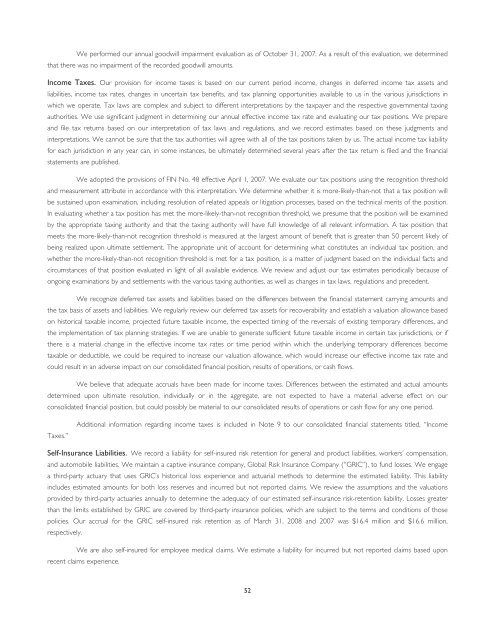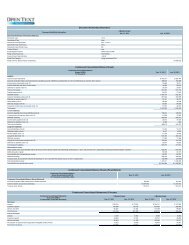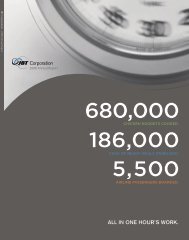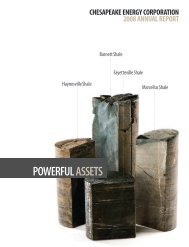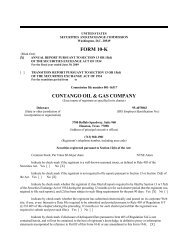On the Surface
On the Surface
On the Surface
You also want an ePaper? Increase the reach of your titles
YUMPU automatically turns print PDFs into web optimized ePapers that Google loves.
We performed our annual goodwill impairment evaluation as of October 31, 2007. As a result of this evaluation, we determined<br />
that <strong>the</strong>re was no impairment of <strong>the</strong> recorded goodwill amounts.<br />
Income Taxes. Our provision for income taxes is based on our current period income, changes in deferred income tax assets and<br />
liabilities, income tax rates, changes in uncertain tax benefits, and tax planning opportunities available to us in <strong>the</strong> various jurisdictions in<br />
which we operate. Tax laws are complex and subject to different interpretations by <strong>the</strong> taxpayer and <strong>the</strong> respective governmental taxing<br />
authorities. We use significant judgment in determining our annual effective income tax rate and evaluating our tax positions. We prepare<br />
and file tax returns based on our interpretation of tax laws and regulations, and we record estimates based on <strong>the</strong>se judgments and<br />
interpretations. We cannot be sure that <strong>the</strong> tax authorities will agree with all of <strong>the</strong> tax positions taken by us. The actual income tax liability<br />
for each jurisdiction in any year can, in some instances, be ultimately determined several years after <strong>the</strong> tax return is filed and <strong>the</strong> financial<br />
statements are published.<br />
We adopted <strong>the</strong> provisions of FIN No. 48 effective April 1, 2007. We evaluate our tax positions using <strong>the</strong> recognition threshold<br />
and measurement attribute in accordance with this interpretation. We determine whe<strong>the</strong>r it is more-likely-than-not that a tax position will<br />
be sustained upon examination, including resolution of related appeals or litigation processes, based on <strong>the</strong> technical merits of <strong>the</strong> position.<br />
In evaluating whe<strong>the</strong>r a tax position has met <strong>the</strong> more-likely-than-not recognition threshold, we presume that <strong>the</strong> position will be examined<br />
by <strong>the</strong> appropriate taxing authority and that <strong>the</strong> taxing authority will have full knowledge of all relevant information. A tax position that<br />
meets <strong>the</strong> more-likely-than-not recognition threshold is measured at <strong>the</strong> largest amount of benefit that is greater than 50 percent likely of<br />
being realized upon ultimate settlement. The appropriate unit of account for determining what constitutes an individual tax position, and<br />
whe<strong>the</strong>r <strong>the</strong> more-likely-than-not recognition threshold is met for a tax position, is a matter of judgment based on <strong>the</strong> individual facts and<br />
circumstances of that position evaluated in light of all available evidence. We review and adjust our tax estimates periodically because of<br />
ongoing examinations by and settlements with <strong>the</strong> various taxing authorities, as well as changes in tax laws, regulations and precedent.<br />
We recognize deferred tax assets and liabilities based on <strong>the</strong> differences between <strong>the</strong> financial statement carrying amounts and<br />
<strong>the</strong> tax basis of assets and liabilities. We regularly review our deferred tax assets for recoverability and establish a valuation allowance based<br />
on historical taxable income, projected future taxable income, <strong>the</strong> expected timing of <strong>the</strong> reversals of existing temporary differences, and<br />
<strong>the</strong> implementation of tax planning strategies. If we are unable to generate sufficient future taxable income in certain tax jurisdictions, or if<br />
<strong>the</strong>re is a material change in <strong>the</strong> effective income tax rates or time period within which <strong>the</strong> underlying temporary differences become<br />
taxable or deductible, we could be required to increase our valuation allowance, which would increase our effective income tax rate and<br />
could result in an adverse impact on our consolidated financial position, results of operations, or cash flows.<br />
We believe that adequate accruals have been made for income taxes. Differences between <strong>the</strong> estimated and actual amounts<br />
determined upon ultimate resolution, individually or in <strong>the</strong> aggregate, are not expected to have a material adverse effect on our<br />
consolidated financial position, but could possibly be material to our consolidated results of operations or cash flow for any one period.<br />
Taxes.”<br />
Additional information regarding income taxes is included in Note 9 to our consolidated financial statements titled, “Income<br />
Self-Insurance Liabilities. We record a liability for self-insured risk retention for general and product liabilities, workers’ compensation,<br />
and automobile liabilities. We maintain a captive insurance company, Global Risk Insurance Company (“GRIC”), to fund losses. We engage<br />
a third-party actuary that uses GRIC’s historical loss experience and actuarial methods to determine <strong>the</strong> estimated liability. This liability<br />
includes estimated amounts for both loss reserves and incurred but not reported claims. We review <strong>the</strong> assumptions and <strong>the</strong> valuations<br />
provided by third-party actuaries annually to determine <strong>the</strong> adequacy of our estimated self-insurance risk-retention liability. Losses greater<br />
than <strong>the</strong> limits established by GRIC are covered by third-party insurance policies, which are subject to <strong>the</strong> terms and conditions of those<br />
policies. Our accrual for <strong>the</strong> GRIC self-insured risk retention as of March 31, 2008 and 2007 was $16.4 million and $16.6 million,<br />
respectively.<br />
We are also self-insured for employee medical claims. We estimate a liability for incurred but not reported claims based upon<br />
recent claims experience.<br />
52


